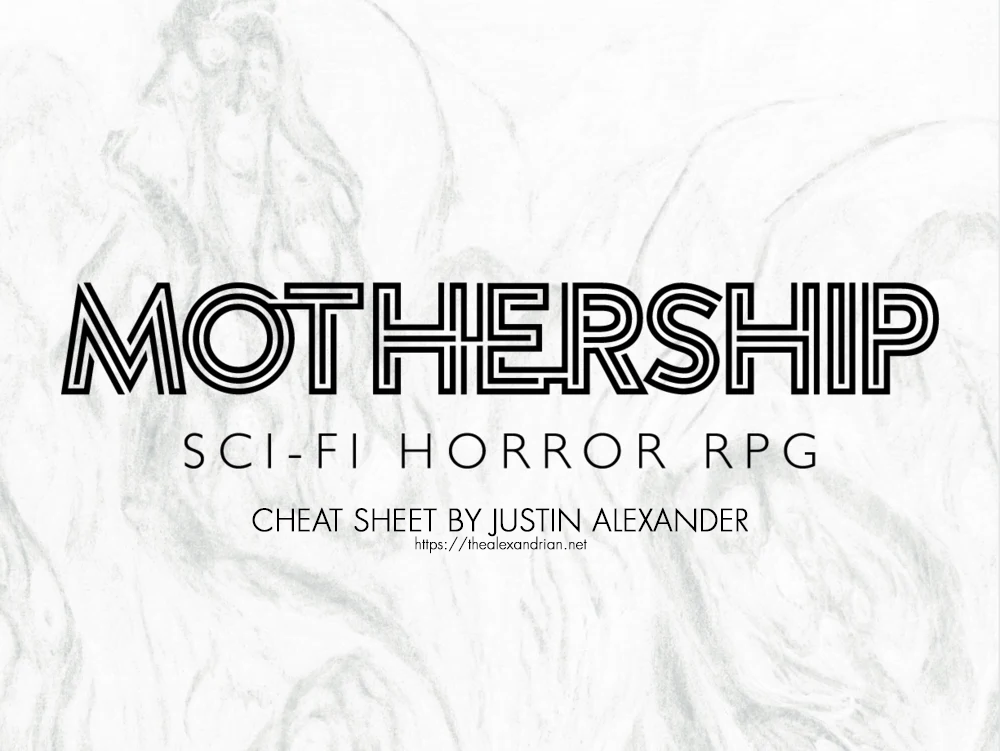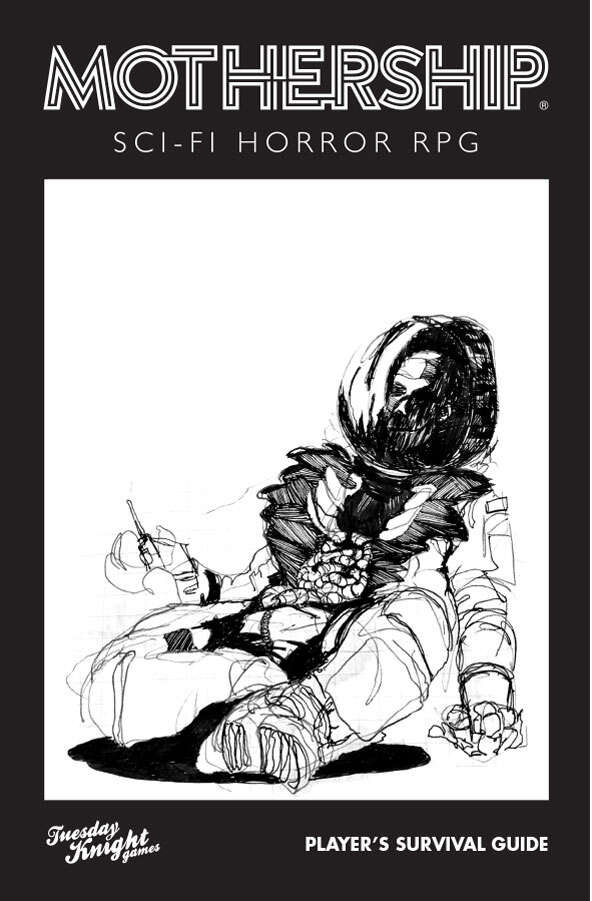AN UPDATED VERSION OF THIS SHEET IS NOW AVAILABLE.
Mothership is a sci-fi horror RPG. Think Alien, The Thing, Pitch Black, or Annihilation.
Its calling card is an old school approach wedded to red hot innovation:
- Blazing fast character creation.
- Brutal systems for Combat and Stress.
- Tons of sandbox support and tools in the Warden’s Operation Manual (the GM book).
- An overwhelming amount of adventure support, including both first party books and a deluge of third-party support.
This last point, in particular, is driving Mothership to my table as my next open campaign. Not only is there a ton of adventure support, a lot of it is designed so that you can spend 15 minutes reading through it and — presto! — you’re ready to go. My expectation is that I’ll be able to rapidly build a stable of adventures that will easily let me run the game with minimal or no prep.
I’ll likely be writing up a full review of Mothership after I’ve had a chance to run it a few more times, but for now I’d like to share the system cheat sheet I’ve developed for the game.
WHAT’S NOT INCLUDED
These cheat sheets are not designed to be a quick start packet: They’re designed to be a comprehensive reference for someone who has read the rulebook and will probably prove woefully inadequate if you try to learn the game from them. (On the other hand, they can definitely assist experienced players who are teaching the game to new players.)
The Mothership cheat sheet, in particular, works very well in conjunction with the GM screen(s) for the game, which are excellent. (There’s both a standard screen and a larger deluxe screen, which each come with the respective boxed sets.)
The cheat sheets also don’t include what I refer to as “character option chunks” (for reasons discussed here). In other words, you won’t find the rules for character creation here.
HOW I USE THEM
I usually keep a copy of the cheat sheet behind my GM screen for quick reference and also provide copies for all of the players. I have two copies of the Mothership rulebook at the table, too, but my goal is to summarize all of the rules for the game. This consolidation of information eliminates book look-ups: Finding something in a dozen pages is a much faster process than paging through hundreds of pages in the rulebook.
The organization of information onto each page of the cheat sheet should, hopefully, be fairly intuitive.
PAGE 1: Basic Mechanics and Violent encounters. (Most of the core game play loops are covered here.)
PAGE 2: Survival. (Most of the miscellaneous rules in the game.)
PAGE 3: Ports & Medical Care. (Stuff to do in your downtime.)
PAGE 4: Contractors. (I debated whether to include this page, but I really want the idea of hiring Contractors to be front-and-center for new Mothership players. It’s such an excellent way of getting them more deeply invested in the campaign.)
Having run character creation for Mothership a couple of times, the sheer speed at which it happens turns the limited number of rulebooks at the table into a significant choke point. I’m going to continue experimenting with how that should be handled, and probably trying to figure out which pages from the PDF need to be printed out to help everyone zip through. (I’ll report back when I know more.)
CRUXES
The Mothership cheat sheet currently only covers the material in the Player’s Survival Guide. I’ll likely be expanding them at some point to include the rules from the Shipbreaker’s Toolkit, but for the moment I’m going to be focusing on in media res scenarios where I’m dropping the troubleshooters into abandoned military bases, butchered research labs, and drifting derelicts.
There are a few interesting mechanical cruxes I’ve had to confront when putting together the cheat sheet.
Unarmed Damage: Unlisted in the core rulebook, this was immediately an issue in my first couple sessions. I’ve pulled the value of 1d5 from Pound of Flesh, an adventure module included in the Deluxe Edition of the game.
Androids & Oxygen: The rules state that androids don’t consume oxygen when life support systems fail, but there are separate rules for vacuums and toxic atmospheres (which require rebreathers or oxygen supplies). Should androids be affected by exposure to vacuum or toxic atmospheres? My ruling is No.
Combat: The transition from an explicitly turn-based initiative system in Mothership 0e to what seems to be a more freeform(?) resolution in Mothership 1e appears to have been pretty badly muffed. The rules and examples of play contradict each other, and support material (including stat blocks and adventures included in the core game box) don’t seem to be in sync with the mechanics. I’ll likely have more to say about this in the future, but for now I’ve simply included the combat rules as written on the cheat sheet.
I’m currently using a system of:
1. The GM threatens harm. (To use a term of art from Apocalypse World.)
2. Players declare action by going around the table.
3. GM makes rulings for how actions are resolved.
4. Players all roll dice (if necessary) at the same time. (Failures likely result in the threatened harm occurring.)
But although this is strongly suggested by the examples of play, I’m not yet convinced it’s actually working very well. (The system seems to detach from the game world, or vice versa, and every opponent kinda blurs into the same mechanical mush.) As I say, I’m going to continue experimenting with this.
MAKING A GM SCREEN
These cheat sheets can also be used in conjunction with a modular, landscape-oriented GM screen (like the ones you can buy here or here).
Personally, I use a four-panel screen and use reverse-duplex printing in order to create sheets that I can tape together and “flip up” to reveal additional information behind them. (This simple sheet, however, will simply fit directly into the four-panel screen.)














Glad you got to the system, its wonderful in its simplicity, i liked focus on one genre and stress and panic system reinforce and support that really well!
I struggled with freeform combat too, curious to know how you end up running it
Unarmed damage actually is listed in the PSG, on the front cover’s comprehensive table of weapons (which also includes the only listing for boarding axes, frag grenades, machine guns, stun batons, and vibechetes). Officially it does strength divided by ten damage. 1d5 is generally what improvised weapons like crowbars do, so it does make sense that unarmed is even lower than that.
@Avian: Thanks! I don’t know why CTRL-F “Unarmed” didn’t turn that up, but good to have it.
@John DMK: Yeah, a large part of it is that the combat system is just schizophrenic. I’ve run lots of systems without initiative or explicit turn order; they work just fine.
But Mothership can’t even figure out if the monsters are supposed to be making checks or if it’s player-facing. And maybe there IS an initiative system or maybe there isn’t? And maybe you’re supposed to just kind switch between all of these options at the GM’s whim?
So you’re left with a heap of contradictory mechanics that you’re supposed to sort of… I dunno… cobble together your own combat system out of?
It’s very messy.
This can be a helpful resource, but you may want to take one more pass on it before offering it for others to use.
A) The automatic critical success and critical failure rolls are swapped.
B) Anti-Armor damage doesn’t just ignore armor, it breaks armor upon hit.
C) The example showing how Bleeding is cumulative omits enough to be incorrect. The “+X” part of “Bleeding” is how much damage per round the bleeding increases by, not a statement of cumulative levels. (If I go from unwounded to Bleeding +2, I’m bleeding 2 DMG/round, not 3. It would only be 3 DMG/round if I were already bleeding 1 DMG/round when I suffer the +2.)
D) The cryosickness reference doesn’t say what happens when you’re cryosick (suffer [-] on all rolls).
E) When exhausted, crew members make a Body Save every hour, starting after 12 hours of activity, not every 12 hours. Failing the save causes both 1 DMG and +1 Stress.
F) 1d10 x max crew capacity = Oxygen supply in days per person, not hours per person.
G) Strenuous activity eats up x3 oxygen (or +2 oxygen), not x2 (each crew member reduces it by 1, THEN those who have been doing strenuous activity reduce it by 2 MORE).
H) Extreme Cold/Heat don’t really jump straight from failed Body Save to Death Save like the reference seems to imply. If you fail your Body Save, you are subject to the effects of the Extreme Cold/Heat, both of which give you some time (but not a lot) to salvage the situation before possibly dying.
I) Artificial Wellness Counselor costs 150cr, not 150kcr. And Deep Tissue Nanogel Massage reduces Minimum Stress by 1, not Stress.
J) Might be good to specify that a critical success during shore leave also resets the character back to Minimum Stress.
The ‘Deep Tissue Nanogel Massage’ grants -1 *minimum* Stress, not -1 Stress.
I was confused for a sec there about the 24kcr price tag!
“00 = Always Critical Failure / 99 = Always Critical Success”
Error. The reverse is true.